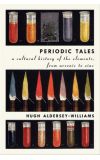
13 Apr 2011 03:35:22
Aldersey-Williams has been trying to collect pure samples of every element known to humankind — from the common to the rare, the inert to the lethal. His quest sprang from a simple desire: to see and feel the elements that otherwise seem to exist only as abbreviations on the periodic table.
The author's scientific sentimentality may be unusual. But he makes it easy to share his passion with his latest book, the charming "Periodic Tales: A Cultural History of the Elements, From Arsenic to Zinc."
Few people give elements a second thought outside of chemistry class, but each one has an interesting story. The quest for gold drove some cultures to explore the world, while other cultures dismissed it as useless. Platinum is as plentiful as gold but it's more valuable because of artificially created demand. And chlorine changed the way nations waged war.
In this context, the elements are surprisingly fascinating. Aldersey-Williams writes about how each element was discovered, explains its place in human history and describes the cultural changes it wrought.
The vignettes are interesting and eloquently written. The only drawback is quantity — with more than 100 elements, it's hard to keep some of the stories straight.
Aldersey-Williams eases the journey by avoiding complex language. Readers won't need a strong science background to appreciate the stories.
A number of interesting patterns emerge throughout the book.
For example, discoveries of new elements typically captured the public's imagination at first. People were easily convinced that the new element had therapeutic benefit, and entrepreneurs would try to capitalize by adding the element — or at least its name — to their products.
Over time, as scientists found side effects associated with the elements, the substances would be phased out and the excitement would subside.
The best part of the book is the author's evident passion. For example, after reading about an alchemist who extracted faintly glowing phosphorus from human urine, Aldersey-Williams tries to duplicate the feat. It's not often that story about urine is so gripping.
"Periodic Tales" is a relatively quick read, and Aldersey-Williams writes with simplicity and elegance. The stories may not help you on your next chemistry test, but they'll help you appreciate the building blocks that are all around us yet all too easy to overlook.

